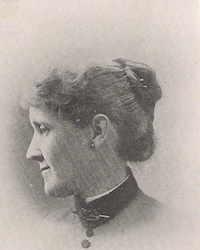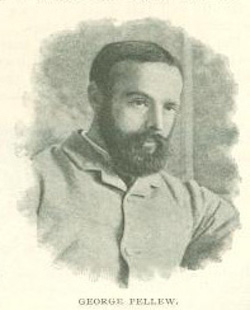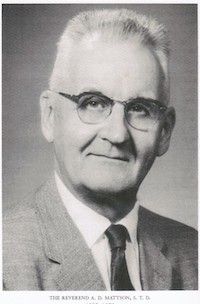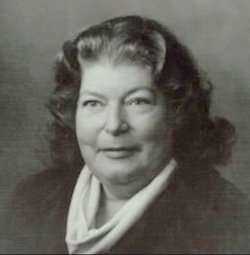A More Comprehensive Look at Trance Medium, Leonora Piper
Posted on 18 July 2022, 7:18
In my 2013 book, Resurrecting Leonora Piper, I attempted to make a case for the spirit and survival hypothesis, i.e., that consciousness survives death in another realm of existence sometimes called the spirit world, by offering some of the best “hits” coming through the trance-mediumship of Leonora Piper, (below) while pretty much ignoring the “misses,” what Professor William James called the “bosh” material. I assumed that most readers would recognize that “her” hits went well beyond chance guessing, coincidence, or deception of some kind. As stated in the book’s introduction, I tried to approach it as a lawyer making a case for his or her client in a courtroom. As I also mentioned, if I were to make a case for Babe Ruth being one of the greatest, if not the greatest, baseball player ever, I would focus on his game-winning hits, not his many strikeouts and other “outs.” The fact is that Ruth’s “misses” far outnumbered his hits, just as Piper’s did.

As I saw it then, the researchers were not offering their reports in layperson’s language and that was the primary reason their findings were not better known and appreciated. Some of their paragraphs extended to two pages and their attempts to remain scientifically objective often obscured their reports. As a journalist of sorts, I saw a challenge in attempting to convert academic writing to something the layperson might better understand.
Dr. Alan Gauld, no doubt the dean of psychical research worldwide, then and now, and most likely the world’s foremost authority on Mrs. Piper’s mediumship, gave my book a mostly positive review in the Journal of the Society for Psychical Research. He pointed out that I was not trying to write a biography or a scientific treatise, and, quoting my own words, said that the book “is simply an attempt to explain the dynamics of [Mrs. Piper’s] mediumship, including the difficulties associated with it, and to offer some of the best evidence for survival after death that came from it.” But Gauld went on to conclude that I was too enthusiastic in endorsing the spirit and survival hypothesis and that I approached the issues from a position at or near that of a “whole-hearted Spiritualist.”
Two of Dr. Gauld’s earlier books were among the references in my book. Before the book was published, I exchanged several emails with him. The only thing I now recall from those references is that he saw the “controls” of Mrs. Piper (Phinuit, George Pellew, Imperator, etc.) more likely as “secondary personalities” of the medium rather than as spirits of dead and said something to the effect that most researchers agree with that position. I inferred from that, as well as from his books, that he was a fence-sitter relative to the survival hypothesis, even though a belief that the controls were secondary personalities does not necessarily mean the person has rejected the survivalist view. I was not then (and am not now) qualified to debate with him, but I do recall noting in our exchanges that the four researchers who spent the most time with Mrs. Piper – Dr. Richard Hodgson, Sir Oliver Lodge, Frederic W. H. Myers, and Dr. James Hyslop – all appeared to accept both the spirit and survival hypotheses while also rejecting the secondary personality aspect of the medium’s control. “…if you assume the control is a spirit, as is more evidently the case for all who have intelligently investigated the problem, you have another mind beside that of the medium with which to deal in the problem,” Hyslop wrote.
In his recently released book, The Heyday of Mental Mediumship: 1880s – 1930s, published by White Crow Books, Dr. Gauld offers a much more balanced account of the Piper mediumship than I did in my book. He discusses many of Piper’s misses, and there is considerably more detail about several of the key cases, including many facts about some of the sitters with Mrs. Piper that I did not encounter in my research of her. He uses the actual names of the sitters rather than the pseudonyms used in the initial reports by the researchers and in my book. However, saying that Gauld’s account is “more balanced” is not to suggest that he debunks Mrs. Piper. In fact, she survives his analyses as a genuine medium and seemingly remains as renowned in the field of mediumship as Babe Ruth does in the baseball arena.
One of the more interesting chapters of Gauld’s book has to do with Tom and Lilla Perry, referred to as Jim and Mary Howard in Hodgson’s initial reports and in my book. George Pellew (G.P.), before his death in 1892, had been close friends with the Perrys. Tom had been one of his instructors at Harvard and the two men formed a close bond. In fact, Pellew lived with the Perrys between 1880 and 1883 and apparently was very attached to Lilla, who, 11-years-older, seems to have been like a big sister to him. Indications are that Tom was well aware of the attachment and did not see it as a threat to his marriage.
Gauld provides quite a bit of background information on the Perrys. Besides teaching English at Harvard, Tom tutored in French and German and “was reckoned the best-read man of his time.” Lilla, the daughter of Dr. Samuel Cabot and a descendant of Benjamin Franklin, was an accomplished musician and linguist. She published several books on poetry and became a world-famous painter, regarded as a pioneer in bringing impressionist influences to the United States.
Gauld adds to the mystery of Pellew’s death at age 32. The first account I read many years ago was that he fell off a horse. Then, a subsequent report had him falling down a flight of stairs at his apartment house early in the morning. A third report had him tripping over a step or two at the entry way to his Manhattan apartment. Gauld states that his body was found in evening dress, lying in the areaway of 70 West 35th Street in the early morning of February 18, 1892, indicating that he had fallen from the area steps, breaking his neck. However, his brother, Charles, is said have identified the body in front of a cigar store that was in fact a gambling establishment. The suspicion seems to be that his parents, very prominent in New York, tried to make his death a respectable one. Whatever the cause of death, a photo of Lilla Perry was found on Pellew’s body.
John Heard (given the pseudonym John Hart in the records), was a friend of both Pellew and the Perrys. He sat with Piper on March 22, 1892, a little over a month after Pellew’s (below) death. Phinuit, then Piper’s control, correctly identified Heard’s father and uncle by name (both named George) as well as the nickname of another uncle named Albert, then asked, “Who is Thom-s…Thomas…Tom?” Heard replied that he is Tom Perry, who is not dead. Phinuit responded, “There is another George who wants to speak to you. How many Georges are there about you anyway?”

Heard placed the photo of Lilla Perry taken from Pellew’s body in Mrs. Piper’s hand. Phinuit then spelled out “ILA, EILA, LILA, LILLA,” then PELLIN and PELLEW, before Pellew broke in, saying “I want to see her awfully. Tell her I am not dead.” (It is not clear, but apparently Pellew spoke directly to Heard using Mrs. Piper’s voice mechanism, not finding it necessary to use Phinuit as a go-between.) Either Phinuit or Pellew spelled out TOM and THOMAS again and also asked about “Mucer” which was changed to “Mercer.” Pellew mentioned that he had lent a book to Mercer.
After some muddled messages, Pellew said, “I want to see Lilla – That’s where the music is. John, if that is you, speak to me! Tell Tom I want to see him. He will hardly believe me…I want him to know where I am – O good fellow!”
Pellew went on to say that another friend, Howells, has a book of his and he wanted Lilla Perry to have it. It was a book of poems by Pellew that he had given to Howells for publication. “I want him to give it to Lilla. I will it to her. Sing. She’ll play for me. She’ll play…” (Lilla was a talented pianist.) The demand was again made at subsequent sittings.
A pair of studs was placed in Piper’s hand and Heard asked who gave them to him. Phinuit, replying for Pellew, said they were his and that he gave them to Heard. However, he corrected himself and said that his mother had given them to Heard, then, again corrected himself and said it was his father who gave them to Heard,. He changed again and said it was his father and mother together that gave the studs to Heard as a keepsake. It was determined that Pellew’s stepmother took the studs from Pellew’s body and his father had sent them to Heard as a keepsake.
Near the end of the sitting, Pellew said (again through Piper’s voice mechanism), “My love to Lilla. What’s Marguerite? Tell her: she’ll know. I will solve the problems, Margaret.” Marguerite/Margaret (referred to as Katharine in the transcript) was the Perry’s eldest daughter with whom Pellew had had frequent talks about philosophical matters. Upon hearing from Heard about the sitting, Tom Perry was much impressed and mentioned that Pellew had once told Margaret that he would “solve the problems” and let her know. After hearing from Heard of his experience with Mrs. Piper, Tom and Lilla arranged for a sitting with her. The first of many took place on April 11, 1892.
In that first sitting, Phinuit opened, but the French accent faded away as Pellew took over and spoke directly, at times writing through Piper’s hand. Pellew asked if Howells had given Lilla the book of poems yet. Lilla replied that Pellew’s father and his brother, Charlie, did not want her to have it. “Strange they should say that,” Pellew said. “That is one of the things we can’t understand here.”
Pellew went on to mention friends Welling and Opdycke, adding that Opdycke was always very fond of him, “though he understood me least of all my friends.” Gauld states that Hodgson confirmed all the references by Pellew to persons, incidents, characters, etc. There is considerably more about the Perrys and Pellew reported by Gauld, much of it veridical, including a sitting in which Lilla brought a lamp to the sitting so that she could better take notes. Pellew apparently recognized it as a lamp he had given Lilla as a gift. In another sitting, Edith Perry, another daughter, was present when Pellew mentioned a book he had given to her in which he had written her name and also commented that she was weak in mathematics. Both were confirmed as fact.
Gauld states that it is clear “that both Perrys – not just the emotionally involved Lilla, but also Tom, whose mind-set had long been that of an eighteenth-century rationalist – were soon disposed to accept the identity of the G.P. communicator with the George they had known.”
Gauld, now 90, devotes about two-thirds of his 324-page book to the study of Mrs. Piper, including, as stated above, many of her misses. I was reminded of much and learned much. I haven’t yet had the opportunity to read the last one-third of the book, but I look forward to it. It includes discussions of “Mrs. Smead,” “Mrs. Soule,” Gladys Osborne Leonard, and other credible mediums of the 1880-1930 period.
The impression I got from reading Dr. Gauld’s earlier books and reports was that he was securely perched on the fence, his more materialistic hand holding tight to that fence while he was looking partly yonder in the spiritualistic direction. After reading what he has to say in this book, I now see him partly dismounted from the fence, one leg still hooked over it and the other leg touching down on the survivalist side while more enthusiastically looking yonder in the survivalist direction. He concludes the book with a comment that he agrees with fellow researcher Stephen Braude that with some cases it “would be not just very difficult but perhaps (in some sense hard to define) illogical to reject the survivalist hypothesis out of hand or at least to fail to give it due consideration.” He adds that a survivalist could justifiably ask an opponent, “What more do you want, what more can you sensibly ask for?”
Michael Tymn is the author of The Afterlife Revealed: What Happens After We Die, Resurrecting Leonora Piper: How Science Discovered the Afterlife, and Dead Men Talking: Afterlife Communication from World War I.
His latest book, No One Really Dies: 25 Reasons to Believe in an Afterlife is published by White Crow books.
The Heyday of Mental Mediumship: 1880s – 1930s: Investigators, Mediums and Communicators by Alan Gauld is available from Amazon.
Next blog post: August 1
Read comments or post one of your own
|
What the Spirits Say on the Abortion Issue
Posted on 04 July 2022, 7:41
With the United States Supreme Court reversing a prior decision in favor of abortion rights, the country is further dividing itself and there is much self-righteousness on both sides. I don’t want to get into politics at this blog and don’t pretend to know which side is right or whether there is an actual moral issue involved. If those opposed to abortion are right about life beginning at conception, then it would seem that there is a moral issue. However, I have been unable to find enough “spirit communication” on the subject to lean too much in one direction. I did find what follows.
“Conception, the union of two cells, instantly sends out a note and a light to the spiritual realm, so that a soul wanting to come to earth is attracted toward that union,” the discarnate Alvin Daniel Mattson (below) communicated through British clairvoyant Margaret Flavell during or around 1972. “In some cases, the soul may have been attracted to those potential parents before. Immediately, a subtle connection is made by the soul with the aura of the mother, and the Angels of Form begin to work on the higher planes to prepare for the entry of the soul into the fetus.”

Dr. Mattson was a Lutheran theologian before his transition from the material world in 1970. He taught for 36 years at the Augustana Theological Seminary, later the Lutheran School of Theology, in Chicago, and was chairman of the Department of Christian Ethics. Flavell was a graduate of the London School of Paranormal Psychology and Sanctuary of Healing. During World War II, she was commissioned by Lord Hugh Dowding, Marshal of the Royal Air Force, to use her psychic abilities to trace missing RAF pilots. The messages were communicated from Mattson through Flavell to Ruth Mattson Taylor, Mattson’s daughter. She was a spectro-chemist with a Master of Science degree from Northwestern University. Fifty-five messages came through from Mattson between March 1971 and October 1973. Many of them were set forth in Taylor’s 1975 book, Witness from Beyond, but those involving abortion are drawn from her 1999 book, Evidence from Beyond.
“When the fetus quickens, the incoming soul seems to become more closely attached to the aura of the mother, but it does not actually enter the physical body at that time,” Mattson explained. “The soul does not actually enter the physical body until the moment of birth.”
Mattson went on to say that he had witnessed the “descending soul” and it appeared to enter the physical body when the baby took its first breath. “If a fetus is aborted in the second or third month of pregnancy, it appears that the in-coming soul has not yet drawn close enough to the auric field of the mother to be too adversely affected,” he continued. “Since it may not be aware of the fact, the disruption is not as drastic as some people believe. However, when you abort a fetus at any point after conception, you are really contravening the creative laws of the universe. You are interrupting a creative process that has been set in motion on many levels.” Mattson added that he would not advocate abortion as a routine method of population control and that family planning should be by birth control before conception.
Silver Birch, a group soul communicating through the trance mediumship of Maurice Barbanell, a London journalist without any religious attachment, was totally opposed to abortion. “From the moment of conception, the spirit has incarnated into a woman’s womb,” Silver Birch communicated. “When it is aborted, it will continue to be a spiritual body, however immature, and grow and develop. You may have destroyed the means of physical expression, but you have not destroyed the spirit that was there.”
Silver Birch went on to say that those who practice abortion will one day be confronted by the spirits that had attached themselves to the fetus at conception.
Bill Wooton, a World War I victim, frequently communicated through the mediumship of renowned medium Lilian Bailey. “When conception takes place the real soul power has not yet entered the physical form of the child in the womb,” Wooton said. “It is well known that when a woman is pregnant, at the half-way stage she feels the “flutter of life.” There is life before that, but it isn’t spiritually evolved. It is only one of the stages of evolution preparing a physical body in the womb to receive the soul. Then, in those first four-and-a half months the soul itself prepares, with all the help from our side to enter the physical form in its embryo condition. Within the seventh month it becomes more vigorously alive.” Wooton did not directly address the abortion issue, but one might infer from what he said that abortion is at least morally contraindicated at some point near the middle of the pregnancy.
Alan Kardec, the famous French educator whose books gave rise to the philosophy known as Spiritism, asked a spirit if the union between spirit and body is definitive at the time of conception. “The union between them is definitive in this sense – namely that no other spirit would replace the one who has been designated for that body. But, as the links which hold them together are at first very weak, they are easily broken, and may be severed by the will of a spirit, who draws back from the trial he had chosen. But, in that case, the child does not live.”
Kardec pressed for a better answer, asking if the fetus has a soul. “The spirit who is to animate it exists, as it were, outside of it; strictly speaking, therefore, it has no soul, since the incarnation of the latter is only in course of being effected; but it is linked to the soul which it is to have.”
Kardec then asked if abortion is a crime. “Every transgression of the law of God is a crime,” came the response. “The mother, or any other, who takes the life of an unborn child, is necessarily criminal; for, by so doing, a soul is prevented from undergoing the trial of which the body thus destroyed was to have been the instrument.”
But what if the mother’s life is endangered by the birth of a child, Kardec questioned. “It is better to sacrifice the being whose existence is not yet complete than the being whose existence is complete,” was the reply.
Kardec also asked if the spirit knows beforehand that the body he has chosen has no chance of living. “He sometimes knows it, but if he chooses it on this account, it is because shrinks from the trial he foresees.”
In her 1979 book, Life Before Life, Helen Wambach, Ph.D., (below) a psychotherapist, tells of past-life regressions she carried out with 750 patients. Among the questions she put to them was one having to do with when the soul enters the fetus. “In summary, 89 percent of my subjects expressed the feeling that their consciousness was something separate from that of the fetus, and they did not experience inside the fetus to any degree until at least the sixth month,” Wambach writes. “A majority of the subjects did not experience the fetus until just before birth. Of those who reported joining the fetus from conception to four months, their description indicated they might have also been experiencing in and out of the fetus. Eighty-six percent of all the subjects said that they became aware of the feelings, emotions and even thoughts of their mother before they were born. Many of the subjects said that they were aware of the mother’s feelings because they themselves were not locked into the fetus, but instead seemed to be hovering around it.”

Wambach concluded that the soul “has a choice of which fetus to enter. If one fetus is aborted, apparently it is possible to choose another. In some cases, the soul who will occupy the fetus is in contact with the soul of the mother and can influence her decision regarding abortion.” Her research also indicates that souls “can elect to leave the fetus or the infant’s body and return to the between-life state.” Wambach wondered if the sudden death syndrome in infants is the result of such a decision by the soul.
Those who don’t believe in spirits and those who believe that spirits are all advanced infallible beings will likely have a good laugh at the conflicting explanations here. I must confess that it is the first time I can recall questioning the teachings of Silver Birch, as I find the words of Wooton and the research of Wambach more consistent with other teachings coming from the spirit world. Moreover, I lean slightly toward the final conclusion of Mattson relative to motivation. At the same time, I accept other communication stating that spirits are at various levels of advancement and don’t have all the answers, and further that communication from them can be distorted by the medium’s subconscious mind or by devious earthbound spirits. Clearly, much discernment is required.
Michael Tymn is the author of The Afterlife Revealed: What Happens After We Die, Resurrecting Leonora Piper: How Science Discovered the Afterlife, and Dead Men Talking: Afterlife Communication from World War I.
His latest book, No One Really Dies: 25 Reasons to Believe in an Afterlife is published by White Crow books.
Next blog post: July 18
Read comments or post one of your own
|